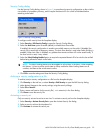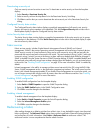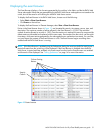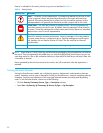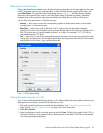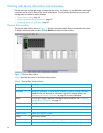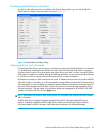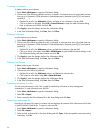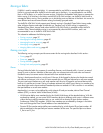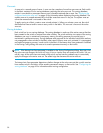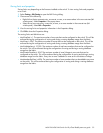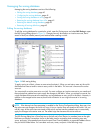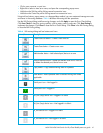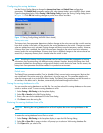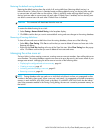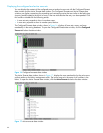McDATA® 4Gb SAN Switch for HP p-Class BladeSystem user guide 37
Zoning a fabric
If HAFM is used to manage the fabric, it is recommended to use HAFM to manage the fabric zoning. If
HAFM is not used and other McDATA switch models are in the fabric, it is recommended to use HAFM
Basic or EFCM Basic, or in earlier firmware versions, SANpilot or Embedded Web Server to manage the
fabric zoning. If all switches in the fabric are McDATA 4Gb SAN switches, use McDATA Web Server to
manage the fabric zoning. Zoning enables you to divide the ports and devices of the fabric into zones for
more efficient and secure communication among functionally grouped nodes.
The McDATA 4Gb SAN Switch supports port/domain zoning in Standard/Open Fabric interop mode,
other M-Series directors and edge switches do not. Therefore, only WWN zoning is supported in
Standard/Open Fabric interop mode when McDATA 4Gb SAN Switch is attached to other McDATA
switches. Fibre Channel address zoning is not supported by other McDATA switches, and is not
recommended for use in McDATA 4Gb SAN Switch.
This subsection addresses the following topics:
• Zoning concepts, page 37
• Managing the zoning database, page 40
• Managing the active zone set, page 43
• Managing zones, page 46
• Merging fabrics and zoning, page 48
Zoning concepts
The following zoning concepts provide some context for the zoning tasks described in this section:
• Zones, page 37
• Zone sets, page 38
• Zoning database, page 38
• Zoning limits and properties, page 39
Zones
Zoning divides the fabric for purposes of controlling discovery and inbound traffic. A zone is a named
group of ports or devices. Members of the same zone can communicate with each other and transmit
outside the zone, but cannot receive inbound traffic from outside the zone.
Zoning is hardware enforced on a switch port if the sum of the logged-in devices plus the devices zoned
with devices on that port is 64 or less. If a port exceeds this sum, that port behaves as a soft zone member.
The port continues to behave as a soft zone member until the sum of logged-in and zoned devices falls
back to 64, and the port is reset. Zoning is hardware enforced only when a port/device is a member of no
more than eight zones whose combined membership does not exceed 64. If this condition is not satisfied,
that port behaves as a soft zone member.
Membership in a zone can be defined by switch domain ID and port number, device Fibre Channel
address (FCID), or device World Wide Name (WWN).
• WWN entries define zone membership by the World Wide Name of the attached device. With this
membership method, you can move WWN member devices to different switch ports in different zones
without having to edit the member entry as you would with a domain ID/port number member.
Furthermore, unlike FCID members, WWN zone members are not affected by changes in the fabric
that could change the Fibre Channel address of an attached device.
• Domain ID/Port number entries define zone membership by switch domain ID and port number. All
devices attached to the specified port become members of the zone. The specified port must be an
F_Port or an FL_Port.



